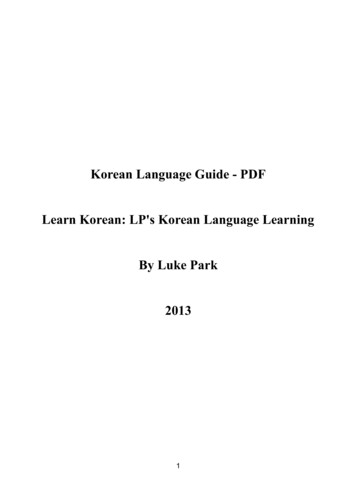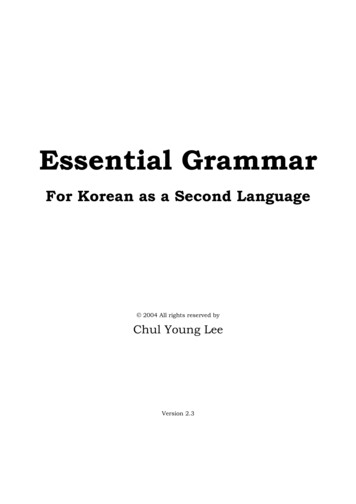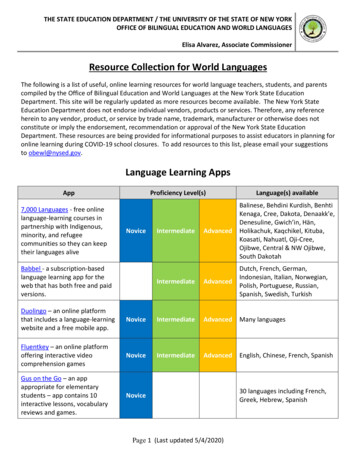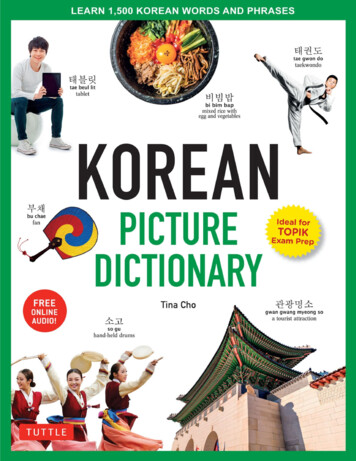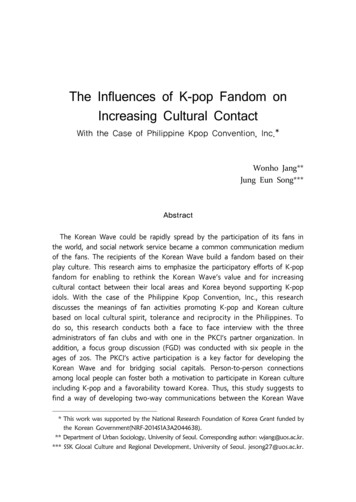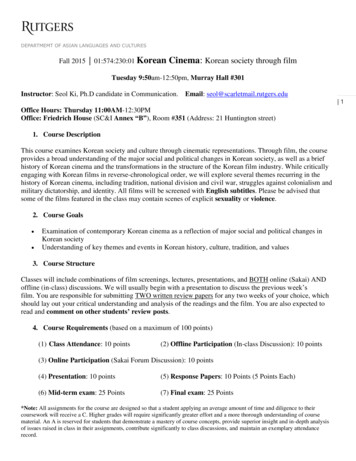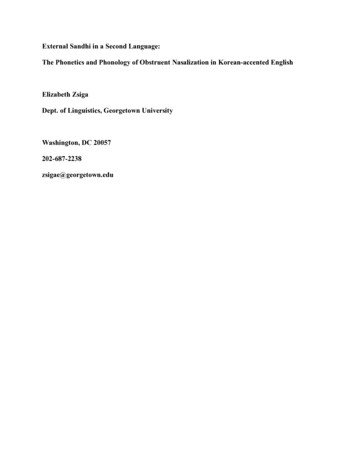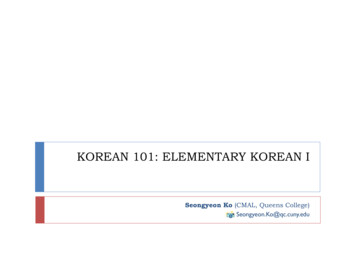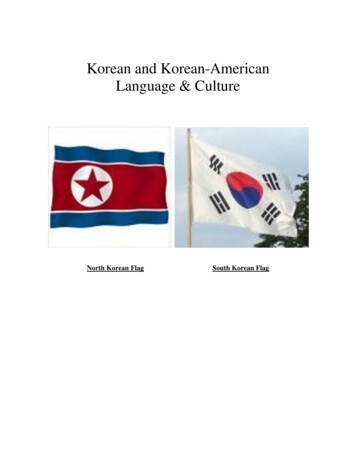
Transcription
Korean and Korean-AmericanLanguage & CultureNorth Korean FlagSouth Korean Flag
Compiled By:Megan Zigler-JohnsonLindsay WozniakBrynn WaggonerTara SimpsonMichelle SaldañaSupervised By:Rahul Chakraborty, Ph. D., CCC-SLPThis manual includes information regarding Korean and Korean-American culture, language,therapy tests and assessments, resources, and contacts. This is not all inclusive. It is a startingpoint for those interested in learning more about this particular culture. Resources provided canaid further investigations into this topic. For a more comprehensive view of the culture, refer tothe references included in this manual and conduct further research as necessary.If you have any questions or concerns,please contact Lindsay Wozniak atlw1290@txstate.edu2
Picture 1. Map of North and South KoreaImage above fromhttp://images.google.com/images?q North and South Korea&btnG Search Images&gbv 2&hl en&sa 23
Korean CultureLanguage and Communication StylesMany Korean immigrants living in the United States today speak Korean and write inHangul, the heritage language of Korea. However, Korean is not the dominant language becausemany Korean-Americans have successfully acquired the use of the English language. ManyKorean immigrants and their American-born descendents use a way of speaking referred to as―Konglish,‖ or code-switching between English and Korean.Different from all the Chinese language dialects, Korean is a phonetic rather than tonallanguage. Also, 50% of the Korean vocabulary comes from the Chinese language. Like manyother aspects of life, Koreans value and promote harmonious social and communicativeinteractions. The Korean culture employs an indirect communication style and is reluctant tocriticize or contradict the other speaker. One style of indirect communication is illustrated byhead nodding and using the word ―yes‖ to actually mean ―no.‖ Furthermore, value is placed onthe ability to read nonverbal cues in order to understand the genuine attitudes, opinions, andfeelings of the other person. Nonverbal communication includes silence and the timing of verbalexchanges, body posture and gestures, facial expression, and eye contact.In heavily Korean-populated areas, there are Korean t.v. channels, newspapers, andmagazines. Many children are sent to Korean schools on the weekends to encourage the Koreanlanguage with future generations. The Korean language is also kept alive by the church whereservices are offered in both English and Korean.Role of the FamilyFamily is the most important aspect of the Korean culture and nothing is done without thefamily‘s permission. The oldest male in the house is considered the wisest and makes most ofthe decisions.Relatives of the same blood are called ―ilga,‖ which means ―one house.‖ Groups ofpaternal relatives are called ―tongjok.‖ They live together in one home and are very close withone another. Relatives from the maternal side of the family can never join the ―tongjok.‖Officials are chosen and the family ―tongjok‖ is run like a small government. The officials holdspecial meetings to discuss things like ancestral rights and the repair of graves. The oldest livingmale makes the final decisions of the meetings and takes care of things like funerals, festivals,graveside rituals, and helps with daily life.Children are taught from a very early age to respect all elders and to take pride in theirancestry. Furthermore, Koreans never forget the dead and respect all those who have passedaway. Families bury their dead on sacred grounds with beautiful trees or shrubs in a pattern.These shrines are built to honor the dead and are consistently kept up.When a parent can no longer care for themselves, the oldest son is expected to assumeresponsibility for the household. When a daughter is wed, she is expected to move out of herhouse and into her husband‘s family household. The oldest son is in the most mourning when aparent dies. The son walks around with his face covered, and although carries on normal dailyactivities, does not meet with people and calls himself a sinful man.4
MarriageArranged marriages are still seen in the upper class of the Korea. These marriages areseen as the joining of two families, rather than two individuals. Because social standing is highlyvalued in the Korean culture, wealthy families want their child to marry the son or daughter ofanother wealthy family. It is believed that wealth brings a life full of happiness and longevity.Although it is not favored by many families, marriages between two people of different socialclasses have become more common in recent yearsIn the Korean culture, a woman‘s role is that of submissiveness, maintaining harmony inthe households, and avoiding conflict.Household StructureFamilies living in the urban parts of Korea have about 4. 8 people in them. There areabout 5.3 people in families living in rural areas. Korean families live with each other, or verynear. These groups of families are called ―clans.‖ Sometimes, up to 4 generations of familiesmay live together. In all households, men and women live in separate rooms on opposite ends ofthe house. Because a woman‘s room is seen as a special place where they can be alone, men arenever allowed to enter the rooms.Korean-Americans represent one of the largest Asian-American populations in thecountry and there are more than one million Korean-Americans living in the United States today.The five-county area of Los Angeles, including Los Angeles, Orange, San Bernardino, Riversideand Ventura counties, has the largest concentration of Korean-Americans. The five-county areaof Los Angeles comprises about 25% of all the Korean-Americans living in the United States,while New York City, northern New Jersey, and the Connecticut-Long Island area constitutesabout 16% of the population.Health Beliefs and PracticesA common traditional health practice of the Korean culture includes a blending ofChinese medicine and folk medicine, such as the concepts of ―yin and yang,‖ and the ―fiveelements‖ of the internal organs. As compared to the United States and Western medicine andculture, many Koreans use very little invasive diagnostic or treatment procedures, prefer herbalover prescription medications, and use massage, acupressure, and acupuncture for healing.Sometimes, Koreans may use a ―pluralistic‖ system of health care, blending traditional foldmedicine with Western medicine.EducationIn the Korean culture, education is held in very high regards. Korean children are trainedto be respectful students by being ―quiet learners‖ and remaining silent while the teacher talks.Therefore, a rather quiet Korean student in an English classroom is not displaying a lack ofknowledge or incomprehension; rather, is being an obedient, quiet student.Korean parents place high expectations on their children, and often times, move to theUnited States for the sole purpose of providing academic opportunities for their children.Korean parents often tutor their own children, as well as send their children to additional5
schooling on Saturdays and during the summer. Some Korean parents may prohibit anyextracurricular activities so the children will have plenty of time for school.DisabilityTraditional Korean beliefs hold that a child‘s disabilities are directly related to themother‘s violation of certain taboos during pregnancy. A popular belief is that a child‘sdisability is a punishment for the sins and moral transgressions of the child‘s parents orancestors. Furthermore, it is a common belief that pregnant women should avoid using scissors,knives, or sharp objects because these may cause a miscarriage or birth defects.Korean ValuesKorean individuals place a great deal of value on family, harmony, and education. Thefamily is the main focus of an individual‘s life and the core of the Korean society. Harmony isviewed as an essential factor for existence. Achievement in education is the greatest honor achild can give to one‘s parents or family. Often times, parents avoid praising their children, andavoid praise given to their children by others. It is believed that an evil spirit may hear thecomplimentary comments and attempt to steal the child.Korean elders are treated with great respect, and are greeted with a verbal greeting and avow. Korean children are trained to respect all elders, adults, and especially teachers. Koreanculture also values virtues such as patience, perseverance, self-sacrifice, maintenance of innerstrength, self-restraint, modesty, and humility.ReligionHigh value is placed on religion in the Korean culture; most Koreans are Christians.Many Koreans find support, cultural maintenance, and promotion through their churchcongregations because many parents do not have time to socialize during the week due toprofessional commitments. Thus, they find community support through their churchcongregations and are able to maintain friendships with other Koreans.FoodThe food of Korea is influenced by the geography- the oceans provide seafood while thefertile grounds of valleys and mountains provide many fruits, vegetables, and different varietiesof rice. Consequently, vegetables and rice make up the majority of the food consumed in Korea.Occasionally, mullet or barely is used instead of rice and other meat besides seafood is alsoenjoyed in Korea. Koreans are known for the use of strong spices such as red peppers, garlic,ginger, green onions, sesame, and soy sauce.Pictures 2 & 3. Korean dishes6
SportsOne of the most popular sports for males in Korea is wrestling.ClothingPeople in Korea usually wear white or light blue clothing. Regardless of the time of year,Korean men and women are usually wearing jackets. Depending on the temperature, paddingmay be added or taken away. Men and women mostly wear pants; however, some women dowear skirts.Pictures 3 & 4. Korean women in Korean dressAll above fm?TextID 397http://www2.bc.edu/ .Korean DemographicsSouth KoreaAgainst the background of ethnic homogeneity significant regional differences exist.Within South Korea, the most important regional difference is between the Gyeongsangregion and the Jeolla region. The two regions, separated by the Jirisan Massif, nurture a rivalrysaid to reach back to the Three Kingdoms of Korea Period, which lasted from the fourth centuryto the seventh century A.D.Interregional marriages are rare, and as of 1990 a new four lane highway completed in1984 between Gwangju and Daegu, the capitals of Jeollanam-do and Gyeongsangbuk-doprovinces, had not been successful in promoting travel between the two areas.South Korea's political elite, including presidents Park Chung Hee, Chun Doo Hwan, andRoh Tae Woo, have come largely from the Gyeongsang region. As a result, Gyeongsang has7
been a special beneficiary of government development assistance. By contrast, the Jeolla regionhas remained comparatively rural, undeveloped, and poor. Chronically disaffected, its peoplerightly or wrongly have a reputation for rebelliousness.Regional bitterness was intensified by the May 1980 Gwangju massacre, in which about200 and perhaps many more inhabitants of the capital of Jeollanam-do were killed bygovernment troops sent to quell an insurrection. Many of the troops reportedly were from theGyeongsang region.Regional stereotypes, like regional dialects, have been breaking down under the influenceof centralized education, nationwide media, and the several decades of population movementsince the Korean War. Stereotypes remain important, however, in the eyes of many SouthKoreans. For example, the people of Gyeonggi-do, surrounding Seoul, are often described asbeing cultured, and Chungcheong people, inhabiting the region embracing Chungcheongbuk-doand Chungcheongnam-do provinces, are thought to be mild-mannered, manifesting true yangbanvirtues. The people of Gangwon-do in the northeast were viewed as poor and stolid, whileKoreans from the northern provinces (now in North Korea) of Pyongan, Hwanghae, andHamgyong are perceived as being diligent and aggressive. Jeju Island is famous for its strongminded and independent women.All above from: http://en.wikipedia.org/wiki/Demographics of South KoreaNorth KoreaSimilar to South Korea, significant regional differences exist in North Korea. However,regional stereotypes have also been breaking down under the influence of centralized education,nationwide media, and the several decades of population movement since the Korean War.It is possible to become a North Korean citizen without being an ethnic Korean - JamesDresnok, a White American, acquired North Korean citizenship in 1972 but immigration isalmost unheard of, and ethnic minorities are negligible.All above from: http://en.wikipedia.org/wiki/Demographics of North KoreaTable 1. A Comparison of North and South Korean DemographicsSouth KoreaSource: CIA World Factbook2006; International ReligiousFreedom Report 2006 fromhttp://en.wikipedia.org/wiki/Demographics of South KoreaYear2006Population:48,846,823Age Structure0-14 years: 18.3%(male 4,714,103/female 4,262,873)GrowthBirth rate:9.38births/1,000population15-64 years: 72.1%(male 18,004,719Total/female 17,346,594) fertility rate:1.25 children65 years and over: born/woman9.6% (male1,921,803 /female2,794,698)Sex Ratioat birth:1.13male(s)/femaleunder 15years: 1.12male(s)/female8
North KoreaSource:Figures from CIAWorld Factbook as of 2009fromhttp://en.wikipedia.org/wiki/Demographics of North Korea2009Population:22,665,3450–14 years: 21.3%(male 2,440,439/female 2,376,557)15–64 years:69.4% (male7,776,889 /female7,945,399)65 years and over:9.4% (male820,504/female1,305,557) (2009est.)Death rate:5.94deaths/1,000population15-99years: 1.03male(s)/femaleInfantmortalityrate: 6.05deaths/1,000live births65 yearsand over:0.63male(s)/femaleNetmigrationrate: e(s)/female (2000est.)Birth rate:14.61births/1,000population(2008 est.)at birth:1.06male(s)/femaleTotalfertility rate:1.96 childrenborn/womanunder 15years: 1.03male(s)/femaleDeath rate:7.29deaths/1,000population(2008 est.)15–64years: 0.98male(s)/femaleInfantmortalityrate: 51.34deaths/1,000live births(2009 est.)65 yearsand over:0.63male(s)/female9
Netmigrationrate: -0.09migrant(s)/1,000population(2009 est.)South KoreaYear2006Source: CIA World Factbook2006; International ReligiousFreedom Report 2006 fromhttp://en.wikipedia.org/wiki/Demographics of South KoreaLife Expectancytotal population:79.05 yearsmale: 75.7 yearsfemale: 82.4 years(2007 est.)totalpopulation:0.95male(s)/female (2009est.)ReligionsNonreligious: 46.92%LiteracyDefinition:age 15 andover canChristianity: read andwrite29.25%Buddhism:22.8%Confucianism: [4][5] - female:96.6%0.27%*[6] (*If it includes (2002)foreignworkers fromMuslimcountrieswho have nocitizenship)Other:0.53% 0.72%North KoreaSource:Figures from CIAWorld Factbook as of 2009from2009total population:63.81 yearstraditionallyKoreanshamanist,definition:age 15 andover canread and10
http://en.wikipedia.org/wiki/Demographics of North Koreamale: 61.23 yearsBuddhist(54%) andConfucianist,female: 66.53 years(2009 est.)someChristian andsyncreticChondogyo(Religion ofthe HeavenlyWay)writeKoreantotalpopulation:99%male: 99%female:99%Korean AmericansThe Korean American community is the fifth largest Asian American subgroup, after theChinese American, Filipino American, Indian American, and Vietnamese Americancommunities. The United States is home to the second largest overseas Korean community in theworld after China.As of 2000, there were approximately 1.41 million Korean Americans, with thebeginning of Korean immigration to Hawaii (United States), large populations in California (esp.in the Los Angeles and San Francisco metro areas), Alabama, New York, Florida, Georgia,Texas, Washington, Illinois, Pennsylvania, New Jersey, South Carolina, Maryland, Virginia,Oklahoma, North Carolina, Nevada, and Oregon.Los Angeles, with its Koreatown district, is home to the largest population of Koreansoutside of Asia. Palisades Park, New Jersey has the highest concentration of people of Koreanancestry in the United States at 36.38% of the population. Georgia is home to the fastest-growingKorean community in the U.S., growing at a rate of 88.2% from 1990 to 2000.All above found in: http://en.wikipedia.org/wiki/Korean-Americans11
Fig. 1 Geographic Distribution of Korean Population in the United States in 1990Fig. 2 Geographic Distribution of Korean Population in United States in 2000All above from Wikipedia http://en.wikipedia.org/wiki/Korean American and the Digital Atlas of the United Stateshttp://130.166.124.2/atlas.us1/US0055.GIF12
Adoption of Korean born children is a popular phenomenon in the United States. Inrecent years 56,825 children of Korean nativity and place of birth have been adopted by UnitedStates citizens (2000 U.S. Census). In addition, 99,061 Koreans were adopted into the U.S. from1953-2001(Korean Ministry of Health and Welfare, 2002).In a 2005 United States Census Bureau survey, an estimated 432,907 Koreans in the U.S.were native-born Americans, and 973,780 were foreign-born. The population of KoreanAmericans that were naturalized citizens was estimated to be 530,100, while 443,680 Koreansliving in the U.S. were not American citizens.All above information from: http://en.wikipedia.org/wiki/Korean AmericanThe Korean LanguageOverviewThe Korean language is spoken by about 70 million people. Although most Koreanspeakers live on the Korean Peninsula and its adjacent islands, more than 5 million speakers arescattered throughout the world.The origin of the Korean language is as obscure as the origins of the Korean people. Inthe 19th century when Western scholars "discovered" the Korean language, their first questionwas which family of languages did the Korean language derive from. These scholars proposedvarious theories linking the Korean language with Ural-Altaic, Japanese, Chinese, Tibetan,Dravidian Ainu, Indo-European and other languages. Today, only the relationship betweenKorean and Altaic (which groups the Turkic, Mongolian and Manchu-Tungus languages) and therelationship between Korean and Japanese have continuously attracted the attention ofcomparative linguists.Altaic, Korean and Japanese not only exhibit similarities in their general structure, butalso share common features such as vowel harmony and lack of conjunctions. Moreover, it hasbeen found that these languages have similar elements in their grammar and vocabulary.Although much work remains to be done, research seems to show that Korean is most likelyrelated to both Altaic and Japanese.All above from htmHistoryAccording to early historical records, two groups of languages were spoken in Manchuriaand on the Korean Peninsula at the dawn of the Christian era. One language belonged to theNorthern Puyo group and the other to the Southern Han group. Around the middle of the seventhcentury the kingdom of Shilla unified the peninsula, and its language became the dominant formof communication.The Koryo Dynasty was founded in the 10th century and the capital city was moved toKaesong at the center of the Korean Peninsula. From that time on, the dialect of Kaesongbecame the standard national language. The Choson Dynasty was founded at the end of the 14thcentury, and the capital was moved to Seoul. However, since Seoul is geographically close toKaesong, this move had little significant effect on the development of the national language.13
All above from htmDialectsModern Korean is divided into six different dialects: Central, Northwest, Northeast,Southeast, Southwest and Cheju. Except for the Cheju dialect, the dialects are similar enough forspeakers of the various dialects to communicate. This is due to the fact that Korea has been acentralized state for more than a thousand years. The language of the capital had a stronginfluence on the language spoken throughout the country.All above from htmPhonologyThe Korean language is comprised of nineteen consonants and eight vowels. In the finalposition of words there are no fricatives or affricates. If a final stop occurs before a nasal sound,the final stop may be nasalized. In the Korean language there are no labiodentals, interdental, orpalatal fricatives. Initial or final consonant clusters are not present in the language. In Koreanthere is no difference between /l/ and /r/, so these sounds may be used interchangeably.These variations make it difficult for foreigners to learn and pronounce the language. They alsocomplicate the task of Romanization.All above from onemes of the plain stop series are pronounced as unvoiced sounds in the world-initialposition, voiced sounds in the intervocalic position and unreleased sounds in the word-finalposition, e.g. kap (kap) "case or small box" and kap-e " (kabe) in the case." The liquid phonemeis realized as "r" in the intervocalic position and "l" in the word-final position. For example, tar(tal) "moon" and tar-e (tare) "at the moon."Another characteristic of modern Korean is that there are no consonant clusters or liquidsounds in the word-initial position. As a result, Koreans pronounce the English word "stop" intwo syllables, as (swt'op), and change the initial "l" or "r" in foreign words to "n." Recently,Western loan words are beginning to be pronounced with initial liquid sounds.All above from lang/Korean 2/frame 1.htm14
Table 2. Consonants and Vowels in IPABilabial AlveolarVelarㅁ /m/ㄴ /n/plainㅂ /p/ㄷ /t/ㅈ /ʨ/ㄱ /k/tenseㅃ /p/ㄸ /t/ㅉ /ʨ/ㄲ /k/aspiratedㅍ /pʰ/ㅌ /tʰ/ㅊ /ʨʰ/ ㅋ /kʰ/NasalPlosiveandAffricatePostalveolarplainㅅ /s/tenseㅆ /s/Glottalㅇ /ŋ/ (syllable-final)ㅎ /h/FricativeLiquidㄹ /l/All above from http://en.wikipedia.org/wiki/Korean language15
MorphologyIn Korean there is no verb inflection for tense or number. There are also no articles in theKorean language. Relative pronouns are not used and there is no gender agreement withpronouns (Gonzales, 2005).Korean words can be divided into two classes: inflected and uninflected. The uninflectedwords are nouns, particles, adverbs and interjections. Inflected words are verbs, copula andexistential. Each inflected form consists of a base plus an ending. There are about over 400endings that can be attached to the base. In finite verb forms, there are seven sequence positionswhere different endings can occur: honorific, tense, aspect, modal, formal, aspect and mood.Tense has marked and unmarked forms; the marked form is past and the unmarked formpresent. The honorific marker si (or usi) is attached to the base to show the speaker's intention orbehavior honoring the social status of the subject of the sentence.Passives are not as commonly used in Korean as they are in other languages such asEnglish or Japanese. There are many transitive verbs which are not subject to passivisation; forinstance, the verb cu 'give' does not undergo passivisation.All above from lang/Korean 2/frame 1.htmSyntaxKorean is a verb-final language: the verb is always the last part of the sentence. The wordorder in Korean is Subject - Object – Verb (SOV). Parts of speech other than verbs arerelatively free to switch around. For example,―Young-Shik sees John.‖Young-Shik (subj) John (obj)SeesThe syllables in gray indicate what is the subject and what is the object in the sentence.The subject markers are '가' and '이'. When the subject ends in a vowel, '가' is used, and when itends in a consonant '이' is used. The object marker '을' follows when the object ends with aconsonant, and '를' when it ends in a vowel. For example,―Jinsoo rice 16
One of the most common verb endings is the formal (very polite) ending. The use offormal ending depends on whether the verb root ends in a vowel or a consonant.Modifying words or phrases always precede the modified words: adjectives precedenouns, adverbs precede verbs, etc. In the Korean language there are no relative clauses, so theclauses that are used in the language precede the nouns they modify however long they may be.The honorific system is a very important aspect of Korean grammar. Korean is one of thefew languages in the world that has honorific suffixes. -Shi-, is used when exalting the subject ofthe sentence, and -supni-, is used when showing the speaker's respect to the hearer.A comparison chart below shows the degrees of respect in the language.‘Have you eaten your meal?’Table 3. A comparison chart of degrees of respect in meal)V(eat)너밥먹었니?intimate formno honorificintimate verb form당신식사했어요?intimate politeformhonorificintimate polite norificsuper-polite formAll above from lang/Korean 2/frame 1.htmHonorificsWhen talking to someone superior in status, a speaker or writer will use special nouns orverb endings to indicate and respect the subject's superiority. Someone is superior in status ifthey are an older relative, a stranger of the family who is of equal or greater age, or an employer,teacher, or customer. Someone is considered equal or inferior in status if they are a youngerstranger, student, or employee. There are endings which can be used on declarative,interrogative, and imperative sentences; and both honorific or normal sentences. These endingsallow Korean speakers to use the language faster and easier.All above from http://en.wikipedia.org/wiki/Korean languageSpeech LevelsThere are seven speech levels in Korean, and each level has its own set of verb endingswhich are used to express the formality of a situation. Unlike honorifics — which are employedto show respect towards the referent — speech levels are used to show respect towards a17
speaker's or writer's audience. The names of the 7 levels are derived from the non-honorificimperative form of the verb 하다 (hada, "do") in each level, plus the suffix 체 ('che', hanja: 體),which means "style."The highest 6 levels are generally grouped together as jondaenmal (존댓말), while thelowest level (haeche, 해체) is called banmal (반말) in Korean.All above from http://en.wikipedia.org/wiki/Korean languageSemanticsDuring early language acquisition, Korean children learn nouns and verbs at the sametime. Verbs can stand alone as complete sentences. Overgeneralization frequently occurs withkinship terms. For example, every elderly woman may be referred to as grandmother (Gonzales,2005).The vocabulary of the Korean language is composed of indigenous words and loanwords,the second being the result the influences of other languages. The majority of the loanwords areof Chinese origin, often called Sino-Korean words. This is a reflection of the effect of Chinesecultural influences on Korea. In modern Korean, native words are significantly outnumbered bySino-Korean words. As a result, a dual system of native and Sino-Korean words pervades theKorean lexicon, including two sets of native numbers are used with the shi (the house, i.e. ahopshi, "nine o'clock") but Sino-Korean numerals are used with pun (the minute, i.e. ka pun, "nineminutes"). Modernization has resulted in a steady flow of Western words entering the Koreanlanguage. Technological and scientific terms represent the majority of these loanwords, althoughWestern terms have been introduced into almost every semantic category. South Koreans aremore excepting of loanwords within their language than are North Koreans.All above from htmPragmaticsNonverbal communication is regarded highly in the Korean language. This is due to thefact that Koreans value limited verbal exchange. A higher significance is placed on silenceduring conversations in Korean when compared to English (Gonzales, 2005). Traditionally, theconcept of filial piety was even reflected in Korean speech. The Korean language is endowedwith a complicated and elaborate honorific system. Depending upon who the speaker is talkingto, different word and verb usages are applied, which accurately reflect his or her social standingwith regard to the listener.At meetings and social gatherings, social order becomes an immediate question: whoshould greet whom first, who should sit where, whom should sit down first. Among closefriends, those born earlier are treated as elder brothers and sisters. Among acquaintances, one isexpected to use honorifics to those 10 years older than oneself. If the difference is less than 10years, people are to address one another as equals.All above from htm18
Table 4. The Korean AlphabetConsonantsAll above from lang/Korean 2/frame 1.htmSyllable ConstructionKorean syllables always begin with a consonant followed by a vowel. The syllable is writtenwith the initial consonant on the left or top and the remaining vowel(s) and other consonant(s)following to the right or bottom, like this:가 where ㄱ ―k‖ is the consonant, and ㅏ ―ah‖ is the vowel. It is pronounced ―Kah‖.고 where ㄱ ―k‖ is the consonant, and ㅗ ―oh‖ is the vowel. It is pronounced ―Koh‖.Korean letters are always written with strokes from top to bottom and from left to right. Thissame method is used for reading. The initial consonant is sounded out followed by the vowel(s),making it flow into the other ending consonant(s), if any are present. Spatially, words areseparated by spa
many Korean-Americans have successfully acquired the use of the English language. Many Korean immigrants and their American-born descendents use a way of speaking referred to as ―Konglish,‖ or code-switching between English and Korean. Different from all the Chinese language dialects,

